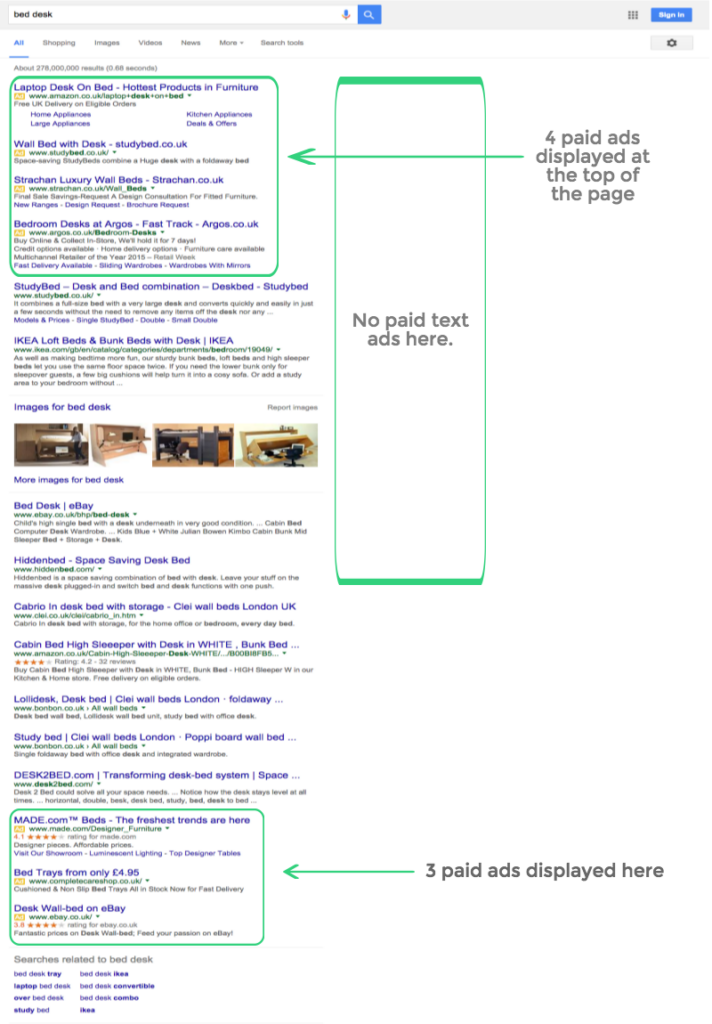By now it’s likely you’ve already heard about Google’s decision to remove PPC ads from the right-hand side of the SERPs (Search Engine Results Pages). If not, fear not. I’m here to walk you through the ins and outs of what Google’s latest PPC change could mean for the search-sphere, and more importantly, your business.
So, what exactly has changed?
The main point is this: On the 19th February 2016 Google stopped showing PPC Ads on the right-hand side of the desktop search engine result pages.
That means the desktop SERPs are looking a little less crowded than before:

Along with removing the side ads, Google has also shuffled some other stuff around:
- There will now be a maximum of 4 sponsored spaces at the top of the SERPs, with additional ads appearing below the organic listings
- The right-hand side space is now being utilised to feature Google Shopping results
So in essence, this (in most cases) means less ad space on each SERP and less organic listing visibility above the fold..
Why the sudden change?
Well, this isn’t completely out of the blue. Google has actually been experimenting with this result page format on selected searches for a while now. Years in fact. However, as far as permanent changes to the Google search results pages go, it’s the biggest in a long time. So why have they done it?
In an article for Search Engine Land, Matt Lawson explained that Google has made the changes because text ads on the right hand of the page ‘are not useful to the user’, a theory that they support by the fact users ‘don’t click on them as much as other ads’. He also explained that the change ‘would improve user experience’, and ‘make user experience consistent across desktop, tablet & mobile’.
So, What does this all mean for mybusiness’s PPC account?
Well, this really depends on your business type and your previous PPC strategy. Google has stressed that the data from testing this change in advance suggests that advertisers shouldn’t see a big impact on their results – but there may be a couple of exceptions where this could hold less truth.
Low Position Strategy Accounts
Businesses who have employed a position-based strategy and have previously relied on the lower ad positions for their traffic may find their click through rate reduce as these positions drop below the fold to the bottom of the page. If this is the case, they may need to re-evaluate their strategy, and possibly invest more into Adwords in order to maintain their paid visibility.
Accounts With High Commercial Intent
Google has said that high commercial intent searches (search terms where the user is very likely to make a purchase) are the ones where you’ll be more likely to see the 4 text ads at the top of the page. Due to this, companies bidding in these markets are more likely to see a gradual increase in CPC (Cost per click) as businesses attempt to gain the higher positions in order to secure sales.
Highly Competitive Industries
Companies that have been dominating the top 3 positions for their search terms shouldn’t see too much of a difference in their traffic. However, companies working with low budgets in this space are likely to see a loss in visibility. All will likely see CPC’s creeping up as competitors start to increase bids to improve their positioning. Because of this increase in competition, maintaining & improving quality scores will be more important than ever.
Do I need to change my strategy?
There are a couple of things you can do to tighten up and ensure you don’t lose any visibility on the desktop searches.
Make use of Google Extensions
PPC real estate is more important than ever. This means taking up as much room with your ad as possible with all the available (and relevant!) ad extensions. Sitelinks with descriptions, call-outs, call extensions and structured snippets are all great ways to bulk out your ad whilst enhancing your call-to-action.
Be More Aggressive on Mobile
The key thing to bear in mind about this change is that this only affects desktop searches. Most of Google’s searches are now performed on mobile devices, meaning this change won’t actually affect most of Google’s search results. Up your game on mobile and ensure you’re dominating the mobile searches.
Be Savvy with your Ad Scheduling
If you do rely heavily on desktop searches but have budget restraints, use ad-scheduling to ensure you appear as high as possible for the moments that matter. For example, if your historical data tells you that your account gets most of its impressions and conversions on Friday afternoons and Saturdays, allocate the majority of your budget to these times. This way you’ll be most visible when you’re far more likely to convert.
Use RSLA to capture your engaged audience
Use audiences and remarketing for search (RSLA) to target the users that have already shown an interest in your website. You can bid more for these users, meaning your ad will show in a higher position for those already familiar with your brand. Depending on their behaviour, these users are more likely to convert, and if you’re able to maintain a good position for these searches, you’ll appear dominant and authoritative, and you’ll enhance your brand.
PPC at Loom
If you have any other questions about the change to the right-hand side ads or your PPC account in general, don’t hesitate to get in touch with our team. For more information about what we can do for you as a Google Premier Partner agency, give us a call on 0117 923 2021.





